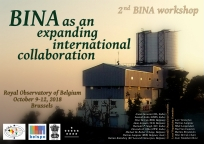Speaker
Dr
Emmanuel Jehin
(STAR Institute - University of Liège)
Description
Comets, asteroids and transneptunien objects are remnants of the early stages of the Solar system and, likely, the most pristine solar system bodies. Understanding their nature and their evolution is a clue to the history of our Solar System and panet formation. Comets and meteorites contain complex organic molecules, and may have played a key role in the transfer of water and organics from the interstellar medium to the early Earth, contributing to the origin of life. This interest is well illustrated by the fact that several space missions have targeted small bodies of the solar system in the past years and comets particularly like the very successful ESA Rosetta/Philae mission that returned impressive science data that are changing our knowledge on comets. In this talk I will review the studies we are involved in my group at the STAR institute of the University of Liège using our TRAPPIST robotic small telescope in Chile and Morocco as well as large telescopes as the ESO VLT.
Primary author
Dr
Emmanuel Jehin
(STAR Institute - University of Liège)

